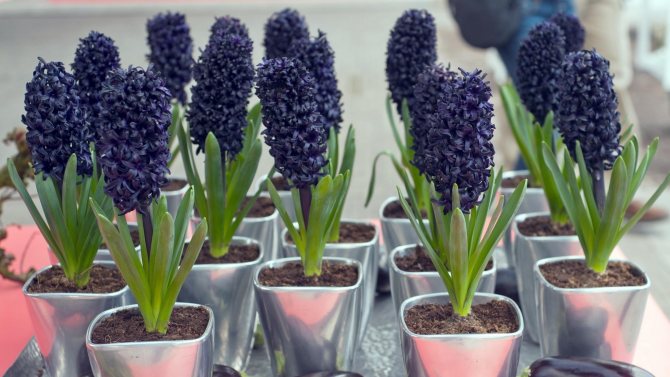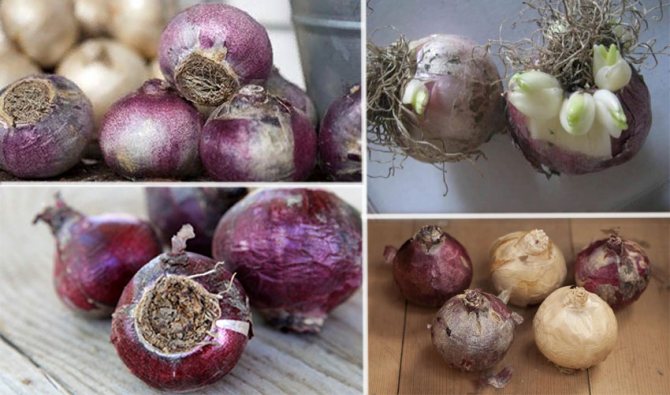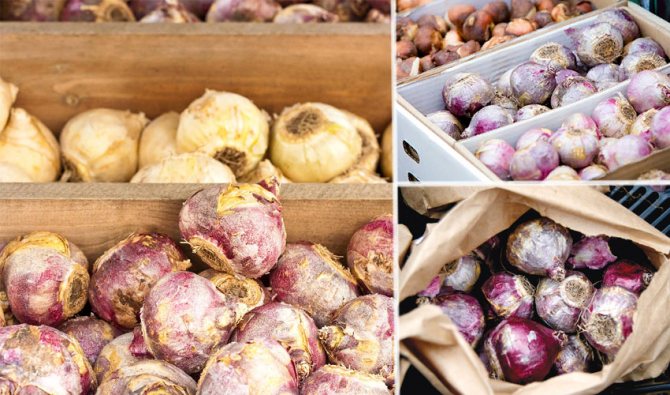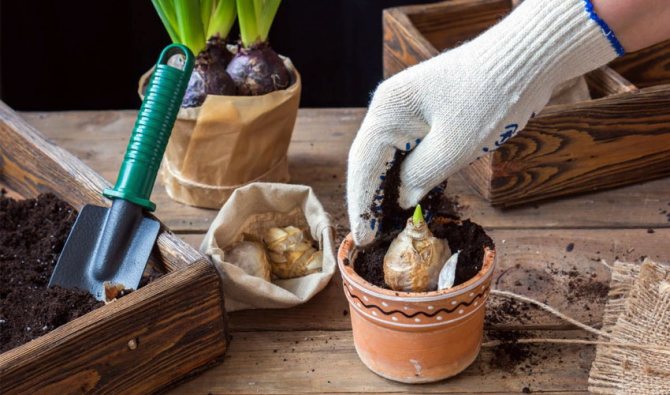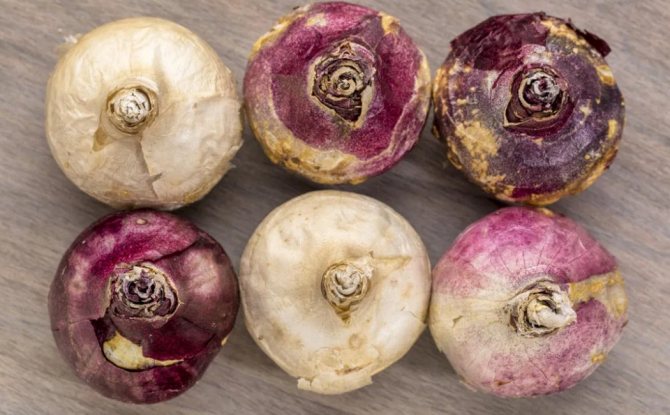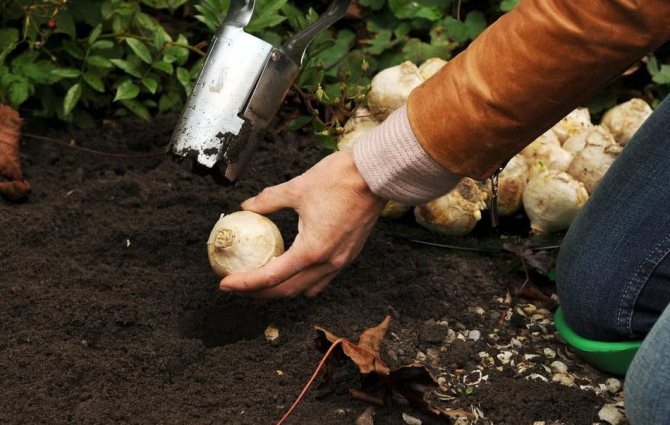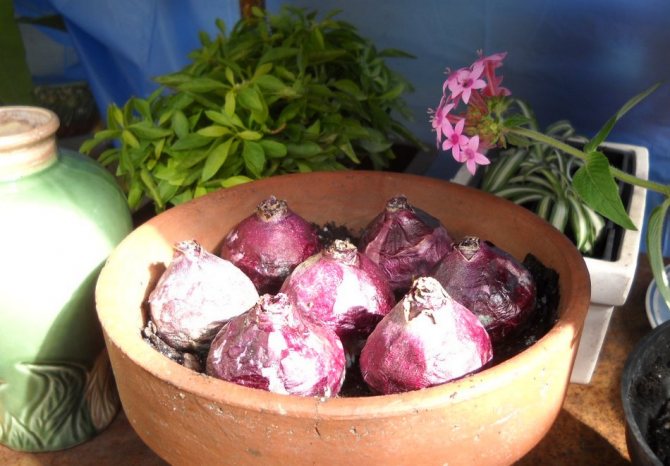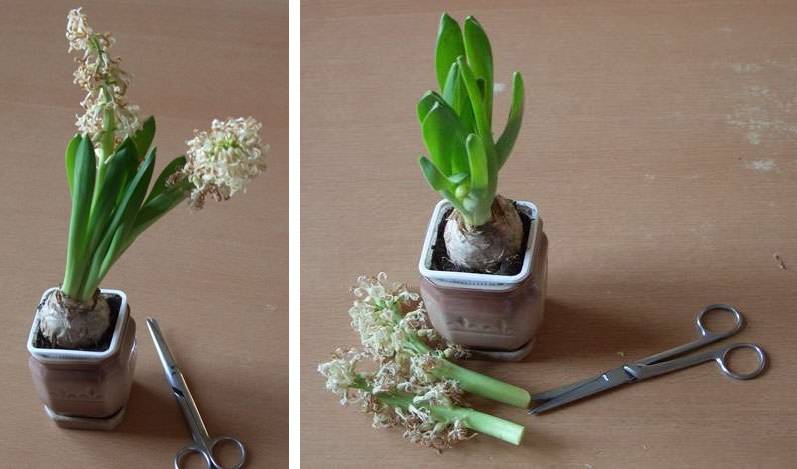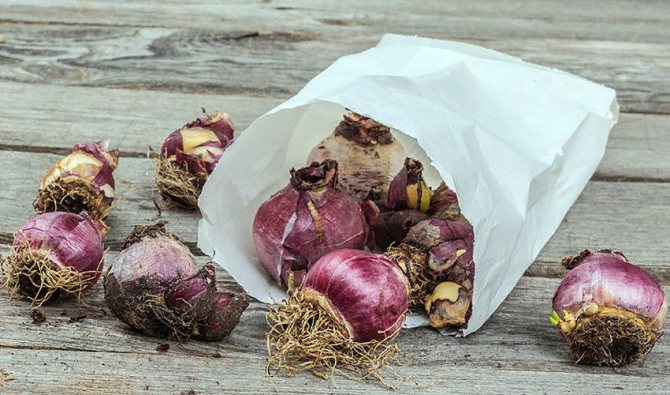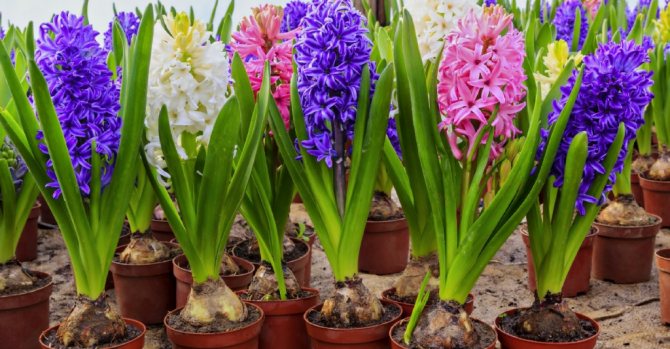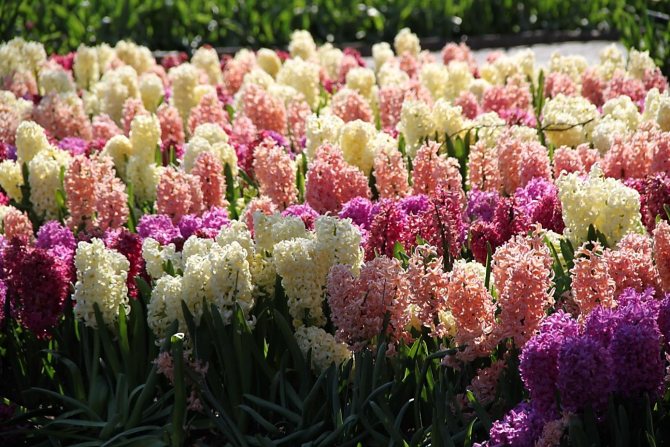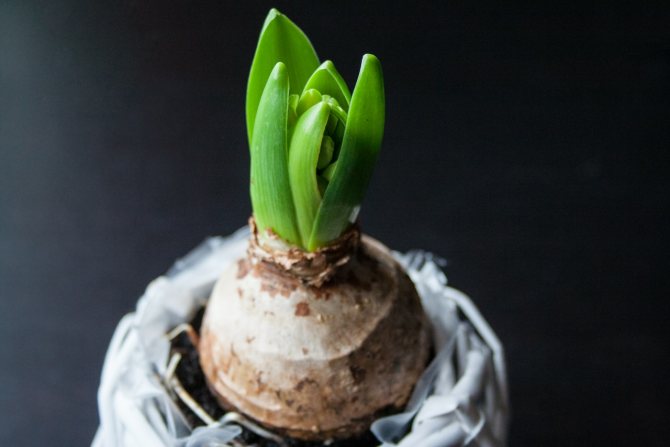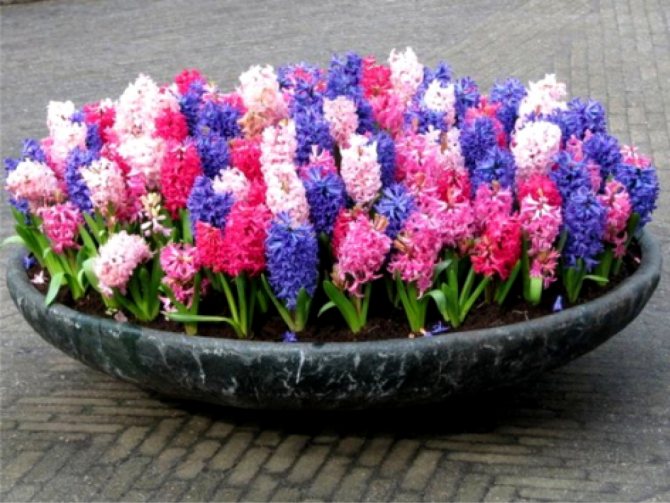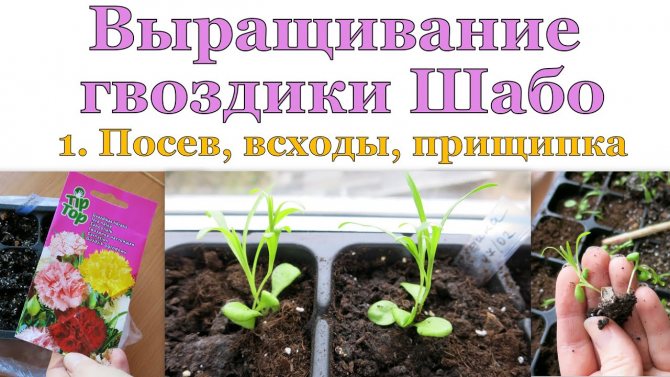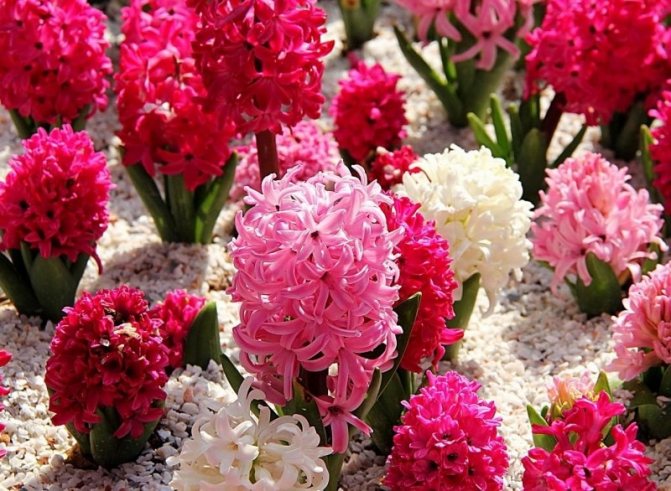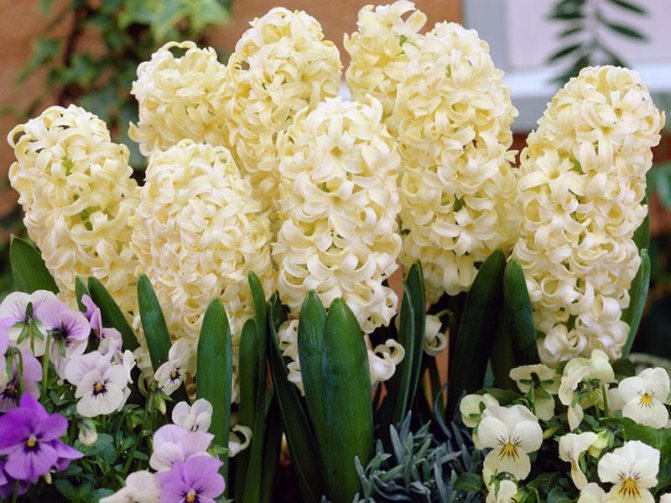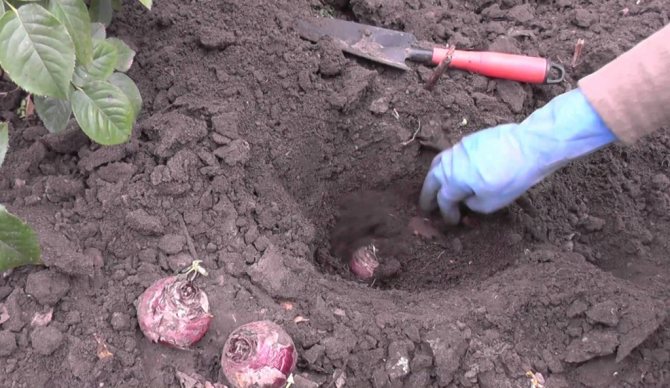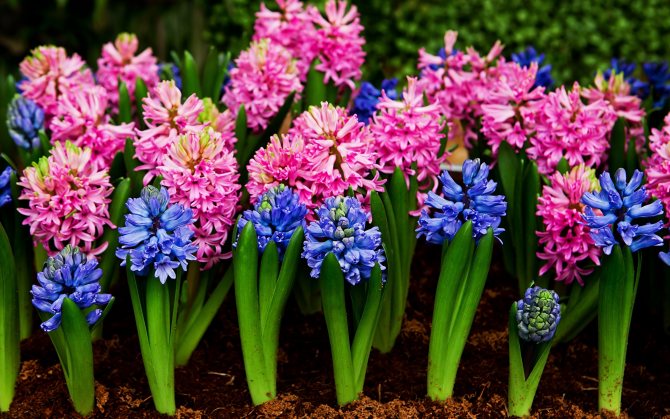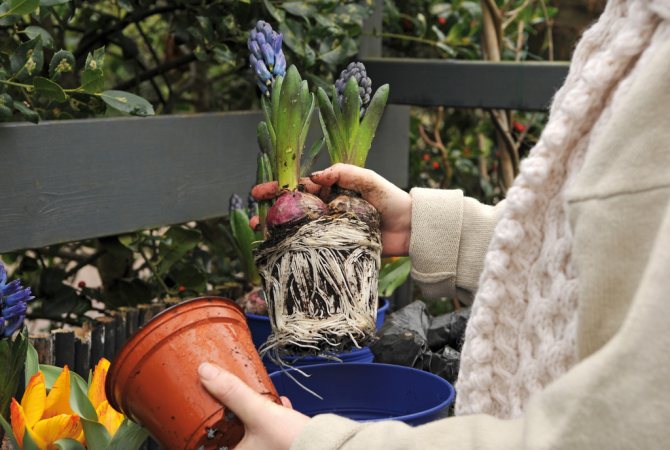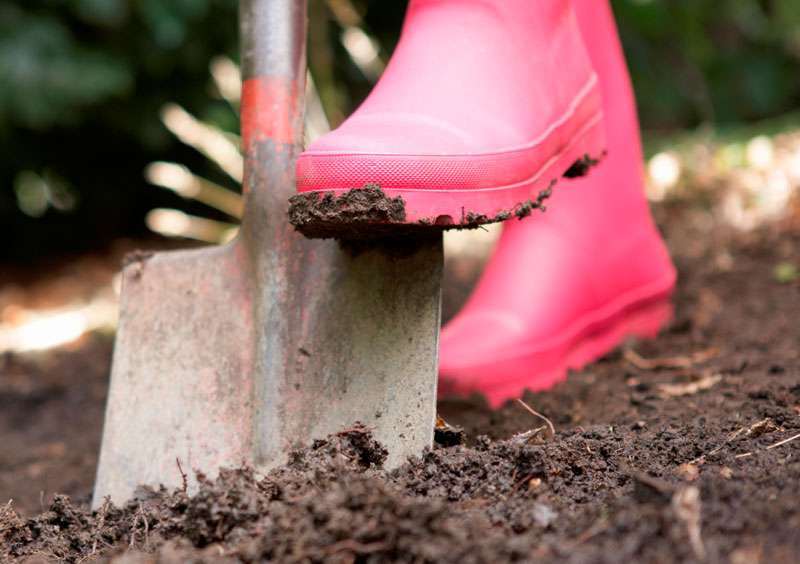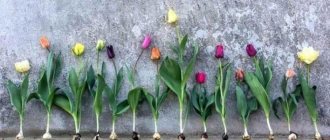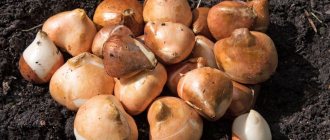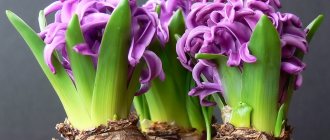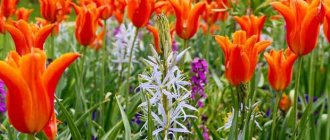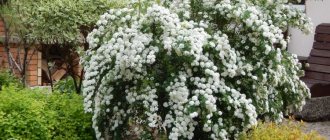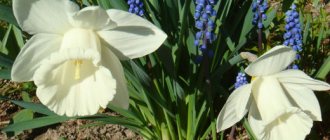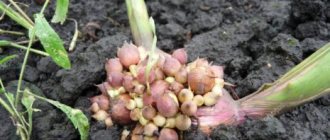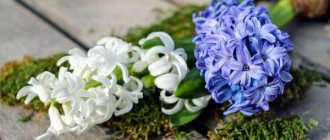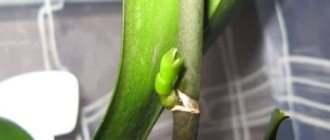The bloom of hyacinths begins with the arrival of spring heat, and lasts from March to May. The exact period depends on the plant variety and climatic zone. The flowering period is 10 - 20 days. Moreover, the first to bloom are blue hyacinths, and the last to bloom are yellow and orange varieties. Many summer residents are interested in how to store hyacinths after flowering at home. Let's try to understand this issue.
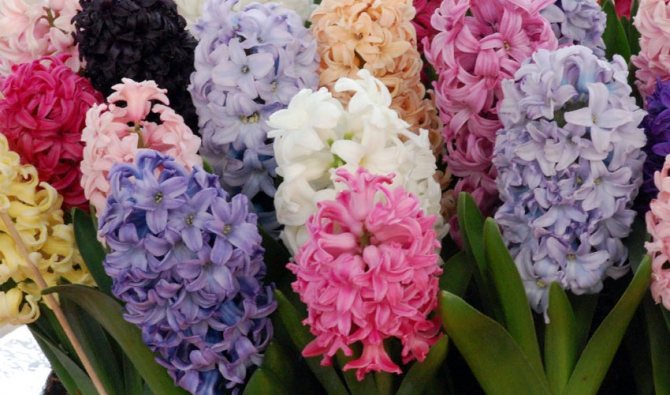
Leave in the ground or not
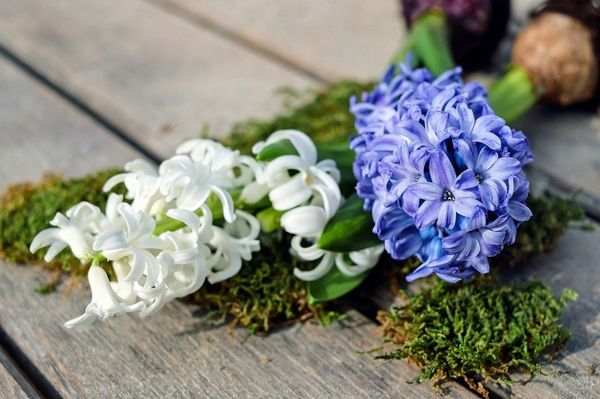

Novice florists often have a question whether it is necessary to dig up hyacinths for the winter. The answer is unequivocal: yes. There are several reasons for this:
- The homeland of hyacinths is the southern countries, and therefore the thin peel on their bulbs is not designed to protect against moisture. During the dormant period, when they stop consuming water for food, even a slight dampness due to ordinary rain can lead to decay and death of the plant.
- Mice eat hyacinth bulbs with pleasure.
- The mother's bulb can throw out several small weak babies, which will die and thereby lead to the decay of the entire plant.
- Even if the hyacinth survives the winter, the re-flowering will be inexpressive and meager, and the plant itself will be weakened and painful. At the same time, rest outside the soil increases the immunity of this flower and strengthens its strength.
- After digging, the bulb can be inspected and, if necessary, cleaned of children or rotten areas.
Leaving hyacinths in the ground is possible only in the southern regions. In this case, it is only important to plant the children in a timely manner so that they do not thicken the planting - this harms the flowering.
Optimal digging time
Now let's find out when to dig up hyacinths. It is believed that the best time for harvesting is late June or early July. However, depending on the region or the weather, this period may shift, so it is best to focus on the appearance of the plant itself. If the leaves of the hyacinth are completely yellow and withered, then it's time to dig it up. You should not wait for the moment when the above-ground part completely collapses and decays - in some cases it will be problematic to find the bulb after that. However, note that you should not rush to harvest the still green plant: in the period between the end of flowering and the complete wilting of the leaves, hyacinth just accumulates useful substances for the new season. If you dig up a bulb with partially green leaves, it will be emaciated and will not bloom next spring or will form few buds. In addition, there is a risk of injury to living roots, which will lead to physiological or infectious diseases. Moreover, this applies to plants that have not yet had time to finally bloom. During this period, the hyacinth needs to be properly cared for. Immediately after the flowers wither, the peduncle is cut off with a knife or scissors (carefully so as not to damage the leaves). the shower is reduced, but not completely stopped. At this time, it is recommended to feed the hyacinth with superphosphate and potassium sulfate. Nitrogen fertilizing is not applied. This rule must be observed even if you keep hyacinths in the apartment. Although they are not threatened by excess moisture or rodents, a properly organized dormant period will make new blooms more abundant.True, at home, the growing season lasts longer and complete wilting occurs at the end of July. After flowering and before harvesting, it is advisable to rearrange the flower in a slightly cooler place, shaded from direct sunlight.
How to dig it right
The bulbs are simply shaken out of the pot.
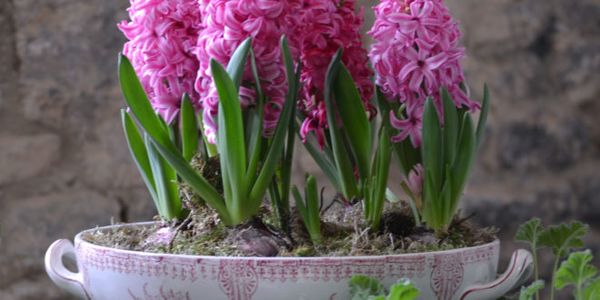

They are dug out of open ground using a pitchfork or a bayonet shovel. This should be done in dry, clear weather. It is advisable to dig deeper so as not to hook the onions themselves. Check that there are no children in the soil.
Shake the removed onions from the ground. If it is a little damp, do not rush to clean it so as not to damage the outer shell - let it dry first. Cut off the wilted leaves.
Before storage, the bulbs are dried for about 5 days in a dry, shaded, well-ventilated area. After that, they are examined a second time. This time, the remnants of roots and dry husks are cleaned off, and the babies are separated from the mother's bulbs. Finally, the planting material is stored away.
Reade set Go
Now we are very close to the question of when to dig up hyacinth bulbs after flowering. The ideal time for this is the end of June or the beginning of July. Since the hyacinth blooms early, by this time the bulb is completely ready to be sent to rest. After the leaves have turned yellow and withered, you can start working. To do this, using a fork, you need to carefully remove the bulbs from the ground and carefully peel them. Remove any remaining foliage and place the bulbs in open boxes to dry out a little. It is very important to place them in a dry and well-ventilated area. Here, questions begin, like: "I dug out hyacinths after flowering, how to store them so that they can calmly wait for the next planting?"
The hyacinth has faded in the pot, what should I do next?
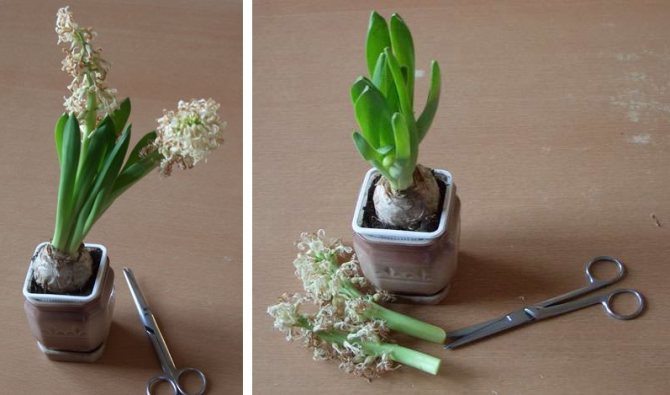

As a rule, hyacinth, bought in a store in a special small pot and timed to coincide with any holiday, does not become an item of care and is thrown away after flowering. But you can do it differently. How? For example, try to preserve the hyacinth bulb (not the hyacinths themselves) after flowering in pots at home by carefully performing the following operation.
Hyacinth, after flowering in a pot with a faded peduncle and still green, but fading leaves, is pulled out of the store container, not bothering much with possible damage to the root system, since later, during storage, the roots will still dry out and fall off themselves. We crush the earthen lump, paying attention to the external state of the bulb and the bottom at the time of decay, after which we separate the upper part.
How to prune hyacinth after flowering at home is no big deal. The green part of the plant is separated from the bulb by a shear cut or a sharp knife. The cut is made at a distance of 1 cm from the top of the bulb. The green part of the plant is thrown away, and the bulb is subjected to antifungal treatment through spraying with a solution of foundationol. If there is no foundation, it can be etched with a dark pink solution of potassium permanganate, after which the bulb must be thoroughly dried and stored in a dark, ventilated place at a temperature of 18-22 ° C. A cardboard or wooden box is ideal as a storage container, but by no means a plastic bag. Before this, each onion is wrapped with newsprint, having previously cleared of the remnants of the earth, old scales, roots and children.
This method does not save 100% of the bulbs, but for a start, if you manage to save at least half of the copies, this will be a good result.
Hyacinths, after flowering at home or indoors, are best transplanted in early autumn into open ground in the garden or in the country. o will help the plant to take root and gain enough strength for normal flowering in early spring.As a rule, this is one of the best tips, but it often happens that there is nowhere to plant the plants besides the apartment. In this case, you can, as an option, transplant the hyacinth bulbs, after flowering has ended and the plant has been at rest for at least three months, into a more spacious container at home. The container itself can be placed on a balcony or loggia, thereby bringing the growing conditions as close as possible to natural ones.
Planting young bulbs
When the babies are already ready to separate from the mother bush, you should not immediately plant them in open ground. It is best to germinate in separate pots. You need to grow them in the future for 4-5 years. In the early years, they will not bloom, but you need to give them time to gain weight and develop sufficiently.
Note! When planting young plants, it is better to reduce the hole in half and cover them with a layer of mulch.
If at the time of flowering the plant did not give leaves, then it makes no sense to dig it up in the future, since all the forces were spent on flowering itself. Here you can only give the plant time and wait until it starts up greenery.
In order for hyacinths to please the gardener with their beautiful flowers, they initially need to be properly looked after and processed. If you pay due attention to the plant, then it will thank you in return with its lush flowering.
How to care for hyacinths after flowering outdoors
After the hyacinths have faded, they must be prepared for a dormant period. The correct eyeliner to this stage of care will be to remove the faded peduncle, without waiting for the appearance of ovaries with seed pods. You do not need to cut the leaves, the longer the foliage remains green, the stronger the onion becomes. After flowering, the intensity of watering is halved, and by the time the foliage dries up, it is completely stopped.
Do not forget about the last dressing, which is carried out immediately after the flowering stage. During this period (after flowering and cutting the peduncle), the bulb begins to intensively recover, gaining strength for further growth. Top dressing should contain superphosphate and potassium sulfate.
The gradual wilting of the yellowing foliage will indicate the place in the flower bed where to find the faded hyacinth for subsequent digging.
Do you need to dig up hyacinths every year?
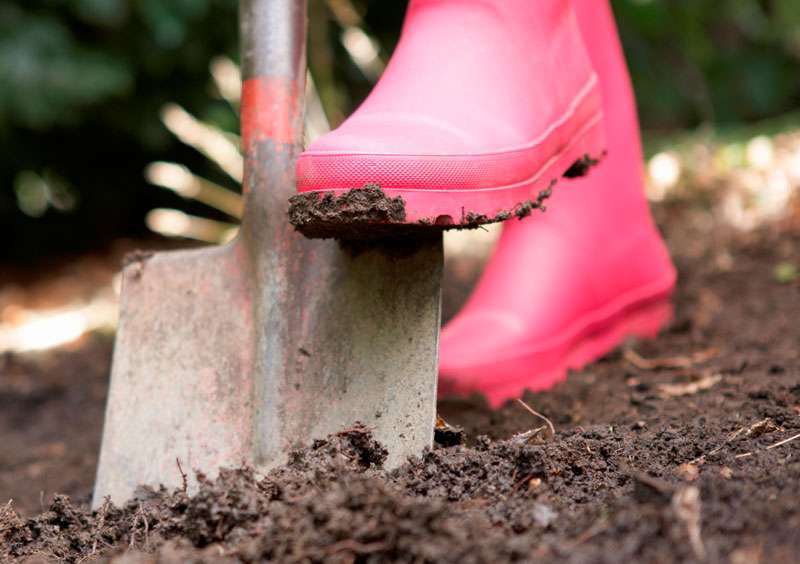

You don't need to dig out hyacinths every year, but leave them in the flower bed. In the natural environment, no one digs out hyacinths for subsequent planting - they grow and develop well without additional human participation for up to ten or more years. Then why bother digging up hyacinths at all?
There are many reasons for digging the bulbs annually, namely:
- During digging, the bulbs are rejected and subsequently disinfected with special solutions.
- The grown children are separated, thereby increasing the seed.
- Bulbous plants rest under certain conditions and temperatures, and recent weather conditions have been unpredictable.
- The next argument in favor of digging is rodents. They love to eat root vegetables. Until the next flowering, hyacinths may simply not survive - they will eat it.
- Excavation and subsequent proper storage stimulates flowering well and the setting of flower buds.
In addition to the above, it is worth paying attention to the fact that the transplantation contributes to the preservation of the decorative qualities and varietal conformity of this or that variety of hyacinth, preventing them from going into a "wild" state in which the plant begins to degenerate.
The choice of planting material
In order for a flower to grow healthy and beautiful when forcing bulbs in winter, it is necessary that it be free of visible defects and rather big, in a word, specially selected.
One onion should be more than five centimeters long. Remember: improper storage or planting can affect the growth and flowering of hyacinths.
If you buy bulbs, keep in mind that the packaging should be marked where the variety is described and whether they can be driven out in winter. Those bulbs that were still in the last cooling season bloom longer.
Hyacinths have faded, what to do with the bulbs?
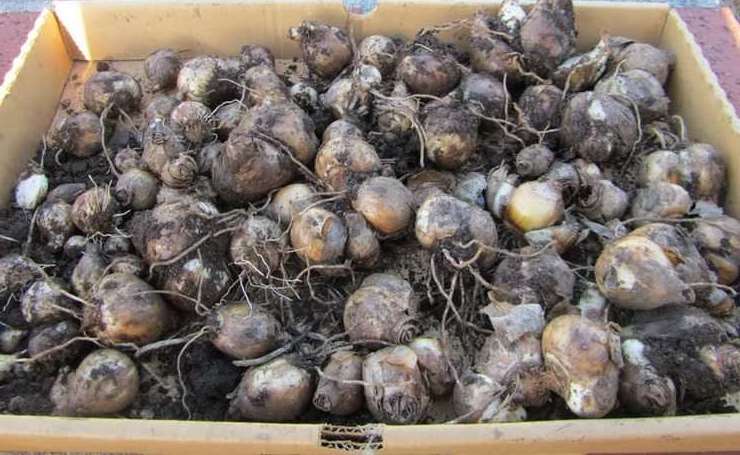

Gardeners often complain that the hyacinth bulbs are not preserved until the next planting. It is useful for beginners to know the correct storage conditions and then the question of how to preserve the hyacinth bulbs will disappear by itself.
The entire storage period from excavation to autumn planting takes three months and is divided into 2 stages.
First stage
The first 5-7 days after digging, the bulbs are kept in the shade to dry completely. The optimum temperature is 20 ° C. After that, you can start cleaning the bulbs. Free them from husks, dried roots, large children, and also treat the hyacinths with a fungicide and dry them.
After the bulbs are dry, you need to put them in wooden or cardboard boxes in one layer. Some growers store the bulbs in paper bags or hanging canvas bags. Prepared boxes with hyacinths are sent to a warm place for 2 months. The optimum storage temperature is 25-26 ° C. The storage area must be well ventilated.
Second phase
During the second stage, the temperature is lowered to 17-18 ° C. When storing bulbs, the main thing is not only temperature, but also humidity. Its optimal value should be in the range of 45-60%. Deviation from the norm will lead to drying of the bulbs. During storage, it is necessary to regularly check the condition of the bulbs: turn over, sort out damaged specimens, separate emerging babies.
All articles about hyacinths on the site can be read by following this link ...
Three months later, in the fall before the first frost, hyacinths are ready for planting in open ground. To prevent freezing, the planting site is covered and lined with a mat of fallen leaves.
Favorable time to dig up the bulbs for storage
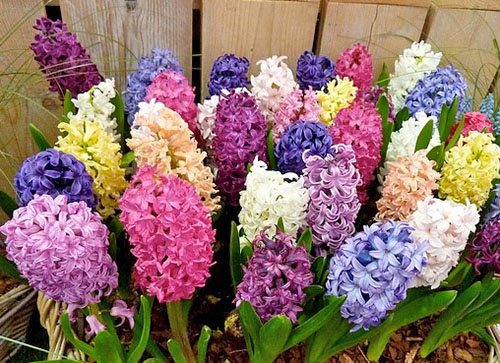

The most ideal time for the digging of hyacinths after flowering to be done correctly is the end of June - the beginning of July. After the leaves turn yellow and begin to dry, you can start digging. The bulbs removed from the ground are carefully peeled, the remaining leaves are cut and placed in plastic ventilated boxes for preliminary drying for 3-5 days in a dry room. Then the dried bulbs are cleaned of excess husk, dry roots, large children are separated and placed in prepared boxes for storage.
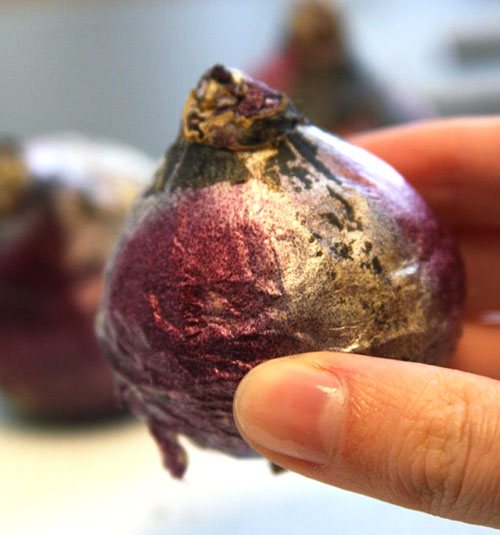

When to dig up hyacinths and how to store them, it's not hard to remember. But there is one more important point, without which success in cultivation cannot be achieved. It is about the storage time of the bulbs. The full rest period is 95 days and of which 60 days, the bulbs must be at a temperature of 25-27 degrees, then they must be kept cool and the temperature must be reduced to 17 degrees. In such conditions, the bulbs will spend another 30-35 days. Don't forget about humidity. So that the bulbs do not dry out at all, you can systematically spray them with water, and ventilate the room.
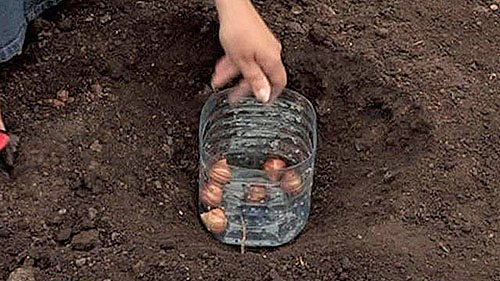

During storage, the bulb will often form small babies that need to be separated and planted in small pots. It is more expedient to grow them for 3-4 years so that they gain volume, and then plant them with everyone.
How to store hyacinth bulbs?
The efficiency of growing hyacinths depends on compliance with the rules for storing the bulbs, since it is during this period that the inflorescences are laid. Delay in digging results in poor flowering. The entire storage period of the bulbs lasts approximately 95 days.
Before storing, the bulbs must be dried at a temperature of 20-22 ° C, having previously removed the remnants of the soil and excess scales. Particular care should be taken when removing scales, under which there may be children.The bulbs are dried in a semi-dark room with good ventilation.
Prepared hyacinth bulbs are laid out in boxes, but no more than two rows. Small shoots should not be separated. If hyacinth bulbs are few in number, they can be stored in paper bags labeled by variety. Further, the bulbs are stored, dividing all operations into two stages:
- first, they should be dried at a temperature of 25-26 ° C, keeping in such conditions for about 2 months;
- at the last stage of storage, lasting 1 month, the bulbs are kept at a temperature of 17-18 ° C, the humidity should not be low, otherwise the bulbs will dry out.
If the first stage is shortened by a week, the bulbs should be kept indoors at a temperature of about 30 ° C. This provides good ventilation If the stored hyacinth bulbs are planted for the winter, they are taken out to a cold room a few days before planting. This allows the bulbs to adapt better to new conditions. It is important that the room where the hyacinth bulbs are stored is humid, the air is constantly supplied with fresh air.
Bulb storage, stage two
After the bulbs have been in the boxes for up to 5 days, they must be removed for re-examination. Now dried bulbs are separated from excess husk and dry roots, large babies are separated from mother bulbs and placed in containers for permanent storage. We have already answered the question of whether it is necessary to dig up hyacinths after flowering, now let's disassemble how long the bulbs need to be stored. The full rest period lasts 95 days. Thus, for a full two months or 60 days, the bulbs should be stored in a dry place at a temperature of +26 degrees. This creates optimal conditions for resting the bulb and its further flowering. Then a little subtlety: the last 30 days, the bulbs should be held in a cool room, in which it is not warmer than +17 degrees. This is what makes it possible to ensure perfect flowering for the next year. At this temperature, the plant will stay for about 30 days. Don't forget about humidity. A damp room is harmful to the bulbs, but they must be sprayed periodically so that they do not dry out.
How to store hyacinth babies?
While cleaning the dug out hyacinth bulbs, babies can be found under the scales. They can be preserved, grown up and quality planting material can be obtained. Usually, many small children form around the bottom of an adult hyacinth bulb. They are separated, dried, and then planted in pots. It will not work to store babies as adult bulbs, since they will simply dry out.
It will take about 4-5 years to grow hyacinth babies. For several years, these bulbs increase their mass without forming a flower arrow. If the children are planted directly into the ground, the planting depth is halved. For the winter, the planting site should be covered with a thick layer of mulch.
Rules for extracting bulbs from the ground
With the correct digging of the bulbs from the soil, the flowers will delight with their unusual flowering for many years. You can keep the hyacinth bulbs blooming for up to 10 years if you dig them up correctly.
A few days before the expected date of digging, the plants stop watering and feeding. The excavated planting material is cleaned of earth residues and washed in warm water. Then they are laid out on the newspaper to dry.
When the bulbs dry up, they are sorted out. It is important that healthy and damaged bulbs are not kept together in the box. If there are traces of damage on them, then such planting material is thrown away. Excess scales are carefully separated (especially if there are children on the bulb) and thrown away.
After all the procedures for preparing hyacinths for winter, you need to choose a container in which they will be stored. It often depends on how successfully hyacinths overwinter.
Flower characteristic
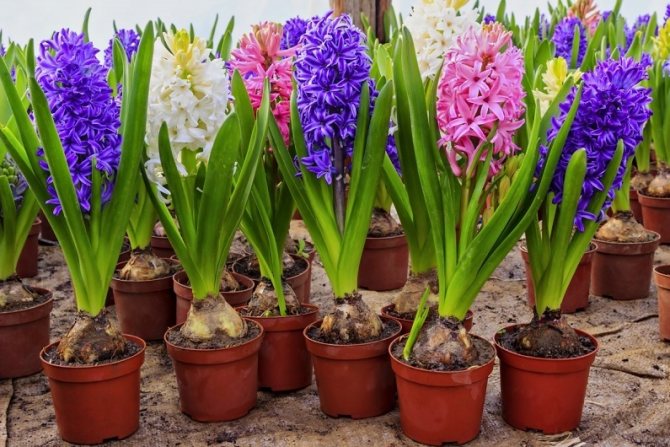

Hyacinth is a bulbous plant consisting of a dense bulb and a flowering stem.Bell-shaped flowers, simple or double, are collected in 20-35 pieces per inflorescence on a stem up to 30 cm high. The flowers have a delicate aroma, when they bloom, they acquire a curly appearance. The color of the flower is different: white, yellow, pink, crimson, red, lilac, blue.
Hyacinths bloom in early spring, as soon as the air temperature reaches +15. Flowering directly depends on the color of the hyacinth, the blue inflorescences bloom first, then pink, then white, followed by red and purple, and yellow and orange flowers bloom last. The color of the future inflorescence of the flower can be determined by the color of the scales of the bulb. Hyacinth blooms for 7-12 days, some modern varieties have a flowering duration of up to 20-25 days. The bulb has a maximum lifespan of 10 years.
Step-by-step activities after flowering hyacinth for open ground
After the end of flowering, the bulbs must be in a state of rest to recuperate, therefore, the necessary procedure is to dig up the bulbs. This allows the plant to fully bloom for the next year. To do this correctly, you need to follow a series of sequential steps.
Hyacinth care before digging out the bulbs
- The wilting hyacinth is left in the soil for some time, while the arrow is necessarily cut off, otherwise the seed pods will begin to ripen, which will take away the strength from the bulb;
- In young hyacinths, the arrows are cut off before flowering, so that a large, strong bulb is formed for planting next year;
- The leaves of the plant are a source of nutrients, so they are not cut off, but left to wilt completely;
- Watering begins to be reduced and gradually removed altogether;
- The last dressing is carried out before digging the bulb, it should consist of phosphorus and potassium fertilizers.
Digging out the bulbs
It is impossible to grow hyacinths without digging the bulb for several reasons:
- Without digging, hyacinth does not bloom the next year or blooms poorly;
- Varietal traits and decorativeness may be lost;
- By digging out the bulbs, diseased specimens can be found and discarded;
- Digging makes it possible to sort the bulbs, and choose the best specimens;
- When digging up, the children are separated for further breeding;
- Digging and subsequent storage stimulates flowering and planting of flower buds;
- The bulbs removed from the beds will not become "victims" of rodents, which can destroy the roots left in the ground.
The bulbs are dug out in late June - early July, while the dried leaves are visible, otherwise the bulb may not be found due to its deep burial.
It is necessary to dig it out very carefully, together with a lump of earth, placing the shovel clearly vertically and deepening it enough so as not to damage the roots.
The most favorable weather for this procedure is cloudy and dry.
Stages of bulb storage
The storage stage is very important, since it is during this period that the future flower is laid. Inside the bulb there is a regeneration bud, due to which the buds of the shoot with leaves and inflorescences, as well as the buds of daughter bulbs, are formed.
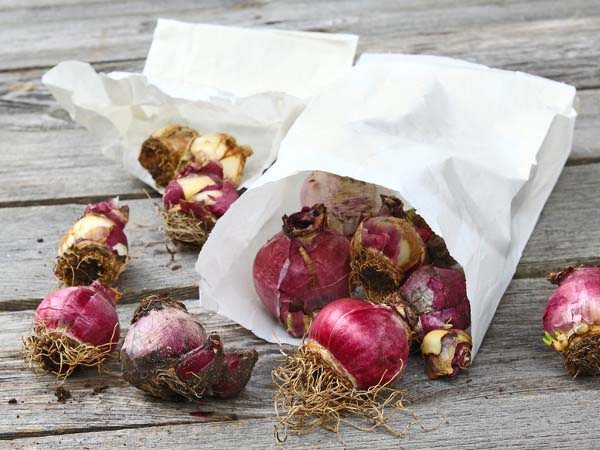

At the first stage, after digging, the bulbs are kept in the air, in the shade to dry at a temperature of +20 ° C, after washing and disinfecting in a solution of potassium permanganate or 3% solution of karbofos (no more than 30 minutes). Usually 5-7 days are enough for drying.
After drying, the bulbs are cleaned of husks and dried roots, separated from large children (it is better not to separate small children) and stored in wooden or cardboard boxes in 1-2 layers, sprinkling with sawdust. Some store bulbs in paper bags or natural fabric bags.
Mandatory storage conditions for bulbs at this stage:
- Storage temperature: first 10 days… + 30 ° C, then until mid-September… + 25-26 ° C;
- Humidity 45-60%, but not more than 70%, otherwise the bulbs will either dry out, or with high humidity they can be affected by fungal diseases;
- Ventilation of the room is necessary, since hyacinths, during storage, emit gas, and without ventilation, the bulb begins to "suffocate". In addition, without air movement, tubers can be susceptible to diseases in the form of bacterial rot;
- Artificial lighting is not allowed, otherwise the bulbs will rot, the room should be dark;
- Containers and tools must be disinfected.
This stage lasts 2 months. During storage, it is necessary to regularly check the condition of the bulbs and discard defective material.
At the second stage, the basic conditions remain the same, except for the temperature, it must be reduced to 17-18 ° C. The duration of the second stage is about a month.
The total rest period for hyacinth is 95 days.
In autumn, a few days before planting, the bulbs are hardened in a cold room at a temperature of ... + 4-5 ° C for better adaptation to the external environment.
Gloves should be worn when handling hyacinth bulbs as they contain oxalic acid and can irritate the skin of the hands.
Planting bulbs outdoors
Sowing of bulbs in open ground is carried out in late September - early October. The timing of planting must be clearly maintained, since with an early planting, the plant can grow and freeze, and with a late planting it will not have time to take root and die. It is advisable to cover the planting site with fallen leaves.
Important! Don't plant hyacinths in spring!
It is necessary to sequentially perform a number of actions:
- Prepare the soil: dig it to a depth of 30-40 cm;
- Apply fertilizers: 1 sq. meter 70 g of superphosphate, 30 g of potassium sulfate or 10 kg of humus;
- Select medium strong bulbs with a diameter of 5 cm;
- Disembarkation scheme: distance from each other 15 cm, depth 15-18 cm (children are planted separately and shallowly - 5 cm);
- Sand is added to the bottom of the hole; growers call it a "sand pillow";
- The bulb is planted in a hole and covered with soil without deepening the root collar.
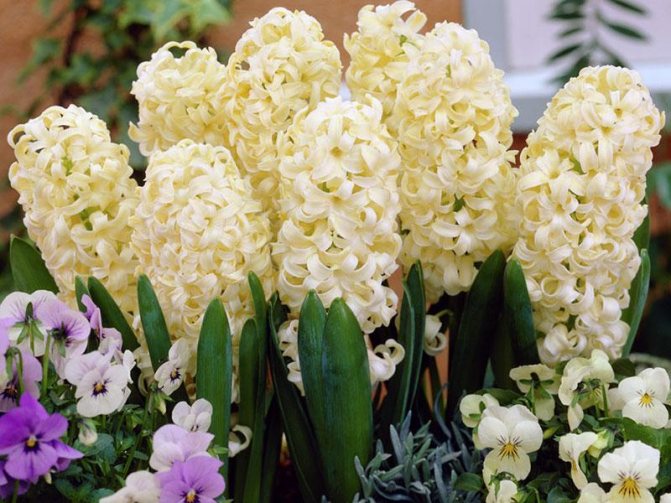

Processing after digging
When to dig tulips
In order for the storage period to pass safely for the bulbs, they must be properly processed after digging up:
- do not immediately separate the roots and leaves. First, you need to gently shake off dry soil and leave in a dry, dark place to allow the bulbs to absorb as much nutrients from the aerial part as possible;
- after the roots and leaves have completely dried, all excess must be removed and the remaining earth must be cleaned;
- the bulbs are washed with cool water;
- you need to warm them up in warm water or 20 minutes. hold maxim in the drug solution;
- at the end, put the bulbs in a dry, dark place and leave to dry for 4-5 days.
The special processing method also contributes to the accelerated reproduction of the plant:
- the bottom of the bulb is cut crosswise with a disinfected and sharp knife;
- dry the incisions.
This type of treatment stimulates the formation of new bulbs at the incision site.
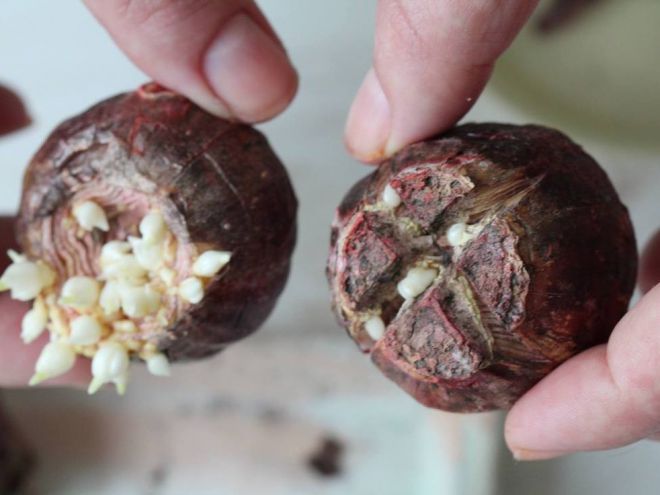

How to cut the bulbs
Note! When planting in the fall, it is not necessary to separate the new bulbs from the mother bush; it is better to leave them to grow for the next season.
Saving indoor hyacinth bulbs at home
For home grown plants in pots, keeping the bulbs after flowering has a simpler algorithm.
After flowering, the inflorescence is cut off, and when the leaves wilt, the bulb is removed from the pot and processed with foundation. The bulb is cleaned of soil, old roots, babies and dried at room temperature. Then it is wrapped in paper and placed in the refrigerator in the fruit and vegetable compartment at a temperature of no more than 5 ° C until autumn, you can use the subfloor. The bulbs must be monitored very closely to prevent drying or decay.
100% no result.According to the reviews of amateur florists, most of the bulbs are lost.
Some people use a different way. To create a dormant period after flowering, the bulb is not removed from the pot, but after removing the ground part, the pot is sent to the basement for 1.5-2 months, maintaining the temperature from +5 to +10 degrees, preventing the soil from drying out.
The rest period can neither be shortened nor increased. If the plant is brought out of hibernation earlier, it will be weak and unlikely to bloom. If you overexpose in the dark, then the flower will throw out the leaves, and the formation of inflorescences will be delayed.
After a dormant period, the bulb is planted in a pot for distillation, and by a certain date or holiday.
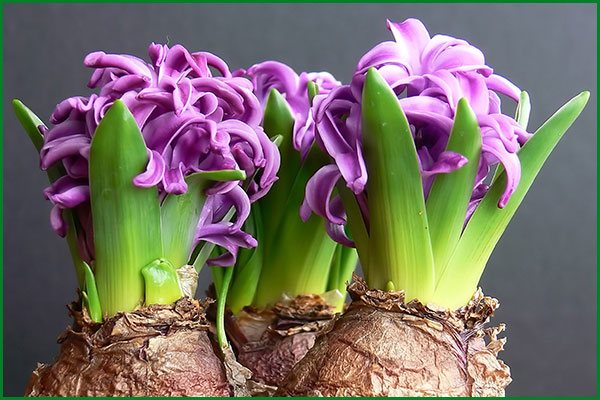

In all countries where this flower is cultivated, it symbolizes happiness and joy. Growing hyacinths at home - for peace and harmony in the family.
Second cycle, planting in soil
We already understood whether hyacinths are dug up after flowering. But what happens to them then? After a long rest period, the bulbs are planted back into the soil. It has already been said that the optimal period for this is the beginning of October. It is already cold enough that the plants do not start growing, but at the same time the soil is not frozen, and they will have time to take root. At the same time, it is very important to guess the timing. Bulbs driven out at home are also planted in the ground in the fall. It is very important to do this before the first frost. At the same time, the plants insulate very well, covering them with a layer of foliage and protecting them with a film from rain and dampness.
Hyacinth distillation care
Hyacinths, which are often sold in small pots, delight us in winter and early spring. They bloom quickly, filling the room with a fabulous scent. Unfortunately, the life of such a hyacinth is fleeting and full of hardships. He suffers from lack of nourishment and thirst, there is little room in the pot for a normal amount of soil. When watering, it is difficult not to soak the bulb, so the substrate in the pot has to be moistened through a tray or gently watered to the very edges and corners of the pot. Hyacinth in a warm room falls to one side and breaks easily. This is because its elongated peduncle with a heavy ear leans towards the light (window), and it is impossible to strengthen the support in a tiny pot.
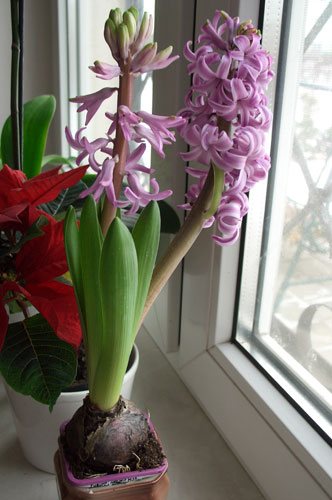

Various techniques help to keep the peduncle in an upright position. From time to time, the pot has to be turned, transferred to a cooler place overnight, or strengthened with improvised means. The peduncle of the hyacinth turns out to be more even, the pot with which stands in a bright and cool place (on a glazed insulated loggia, veranda, in a winter garden, etc.). In addition, winter distillation depletes the bulb.
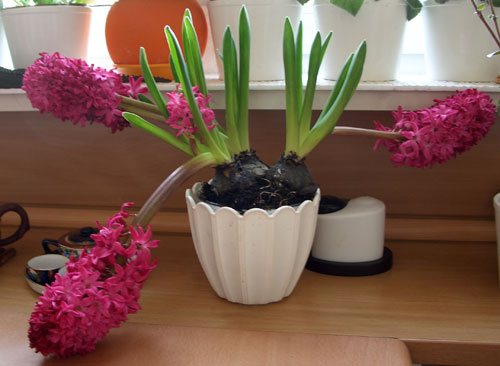

I buy blooming hyacinth in a pot not only as a temporary decoration. I will use this opportunity to replenish my collection of hyacinths. If the newly purchased hyacinth is very cramped, it stays on the roots alone, and there is little left of the substrate, you have to immediately engage in transshipment into a new flower pot. Before that, I well moisten the contents of the old forcing pot and carefully transfer the bulb with roots into a larger container. The main thing is not to deepen the neck of the bulb. It is not necessary to completely cover the bulb with earth. You can add additional soil to it later, after flowering. A flowering plant transplanted into a larger pot is easier to care for. It looks much more interesting, and it can be grown in such a pot after the hyacinth has faded and the peduncle is cut off.
Forcing methods
Forcing hyacinths can be done in two ways: in water or in the ground, each with different conditions, but both options ultimately allow you to get a fragrant bouquet of charming flowers in blue, white, pink or purple.New varieties of plants, bred by breeders recently, have high decorative qualities, including unique color of petals, double forms and new magical aromas.
Forcing in the ground
A multi-colored meadow of spring flowers on the window looks elegant.
Method one - forcing hyacinths in the ground, is not particularly difficult, you just have to carefully perform all the operations:
To begin with, you should prepare a small bowl with a diameter of 12 to 15 cm.Three onions can be planted in such a container. At the bottom of the bowl, you need to make several holes for the water to drain. Fill the bowl with light soil, into which the bulbs are placed along the "shoulders". A third of the bulbs should rise above the potting soil.
The choice of material for distillation is half the battle. You can not use sick and small specimens of hyacinths, flowering may not occur or peduncles will form weak, with rare flowers.
It is not scary if the bulbs touch each other tightly, forcing the peduncles depends only on observing the temperature regime and the energy potential of the planting material.
The bowl is watered, wrapped in newspapers to ensure complete darkness, and then the container is placed in a cool place (temperature +3 C). A vegetable drawer in a household refrigerator is ideal for this purpose, just don't put the pot in a plastic bag. After about 3-4 weeks, an audit is performed. At this time, you can change the wet newspapers, water the dried soil, then continue distillation in a dark, cool place for another month.
As soon as leaves begin to grow from the bulbs, it is necessary to wait for the appearance of peduncles. It is allowed to display hyacinths on a sunny windowsill, in which flower stalks have already clearly formed buds and are slightly colored.
The unsightly yellow leaves of hyacinths literally the next day will begin to turn bright green, along with the leaves, the buds will grow and bloom. As soon as the first petal on the proud peduncle bends back, a magical aroma will immediately fill the room.
Distillation in water
Put the bulbs in the water - just wait until they bloom.
Another way is forcing hyacinths in water. For the successful cultivation of bulbous crops in winter, it is worth preparing high-quality planting material, vessels with a narrow neck and paper or cardboard caps that cover the bulbs.
To begin with, the bulbs are kept in a dark, cool place for about 15 to 30 days. Then the glass vessels are filled with water, the bulbs are placed so that the bottom slightly touches the surface of the liquid. The entire period until the bulbs bloom, it is necessary to periodically add water to the vessels.
On top of the bulb, caps are put on, rolled up of thick paper or cardboard, so that the growing peduncle is in the shade.
Forcing the hyacinths is complete when the bulbs are crowned with strong plumes of fragrant flowers.
Planting hyacinths in autumn
Wild hyacinths are found in the Mediterranean countries, as well as in Asia Minor and Central Asia. There they bloom in early spring, rest in the warm earth, having managed to form a full-fledged flower bud the next year, and in good health leave for the winter.
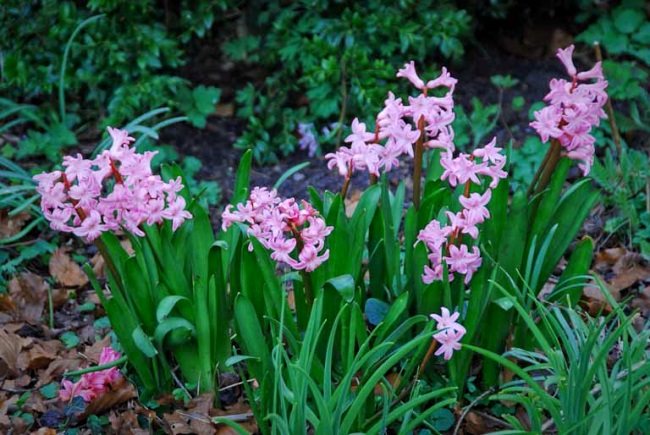

Hyacinth in the wild
In our country, hyacinths do not live so freely: they bloom not earlier than the end of April, fade in approximately closer to June. The remaining time, as well as the heat, is not enough for the heat-loving culture to form the rudiments of a good inflorescence for the next year. This explains the manipulations with the digging and burying of the bulbs: after flowering, the hyacinth remains in the ground, accumulating food, and is "engaged" in the formation of an embryonic bud outside the ground, after digging.
When to plant hyacinth in fall?
Planting hyacinth bulbs held last among all bulbous flowers. This must be done before the ground freezes.Taking into account global warming for the middle band, this will be the second half of October - early October. But you need to look at the situation: early is bad, and late is bad. If planted too early, they will begin to germinate even before the onset of frost; if it's too late, they won't have time to take root before the frost.
Of course, it is quite difficult to guess the exact timing in practice: it’s warm almost until the New Year, or suddenly the first snow will fall in early October. More often, nevertheless, early frosts and prolonged rains create problems. To keep the site dry and warm, cover the ground with plastic wrap or other accessible moisture-proof material after alarming weather forecasts. And generously mulch the sprout of hyacinth that has hatched before winter.
Where to plant hyacinths?
The soil for hyacinths should be either neutral or slightly alkaline. This flower does not like acidic and even slightly acidic soils, therefore, if necessary, the earth is deoxidized with ash, chalk, dolomite flour, etc. (read more about deoxidation here).
You can not plant hyacinth in the shade or partial shade - its flowering will not be as complete as in a lighted place.
Also, when choosing a place for hyacinths, you should take into account the possibility of soaking the bulbs - give up areas where melt water accumulates.
The plot is prepared in advance - around September, so that the soil settles down. If possible, enrich the soil with decomposed manure, peat, or compost.
How to plant hyacinths?
Each hyacinth bulb can live and bloom fully for 10, or even more, years. But for this, the flower must be provided with normal conditions, including the feeding area. For one adult bulb, a 15x20 cm “area” is sufficient. The depth of planting of the hyacinth is of great importance: the neck of the bulb must not be buried, it must remain at the level of the soil.
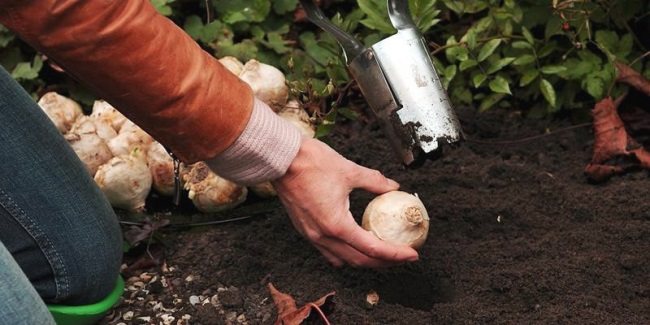

After digging holes, apply fertilizer under each plant (or loosely in the garden). For hyacinths, superphosphate and ash are best; you can use special granules for flowers in open ground. Fertilizers can also be applied during soil preparation, including deoxidation. If the autumn is dry, the hole is watered. This will help the bulbs to take root before frost, and the moist soil does not freeze as much as the dry one.
Very often after planting hyacinth bulbs rot. To prevent this from happening, sand is poured into the bottom of the hole, under the bottom of the bulb, with a layer of two fingers (after watering the hole).
Do I need to mulch plantings of hyacinths? It depends on the climatic conditions of a particular region and the coming winter. Growing hyacinths in the middle lane requires shelter for the winter. This can be spruce branches, compost, sawdust, straw and other materials at hand.
Overwintering water hyacinth
When the temperature drops below 10 degrees, the plant must be brought indoors. More precisely, the future planting material is entered. The main concern is keeping the hyacinth alive for reproduction next summer.
Only young shoots should be taken for storage, the diameter of which is about 10 cm and the roots reach no more than 10 cm in length.
Known storage methods for water hyacinth are overwintering in:
- aquarium;
- sand;
- three-liter jar.
Overwintering in the aquarium
This is not as laborious a process as it might seem at first glance. Choosing this method, you need to take into account some of the nuances. These include:
- Collect water from the same reservoir where the eichornia grew. This is the best option. If this is not possible, take the defended one. Harvest water from the reservoir for the whole winter in advance.
- At the bottom of the aquarium, place silt from the pond native to the hyacinth.
- The water should contain nutrients for the flower. You can add special fertilizers for aquarium plants.
- Normal room temperature is suitable for storage.
- It is advisable to place the aquarium on a windowsill to provide the necessary lighting.In the evening, the plant can be additionally illuminated with a fluorescent lamp.
- To prevent leaf decay, "plant" the hyacinth on a foam float so that the leaves do not touch the water.
Silt storage
- Take a deep pot and fill it with silt from the bottom of the pond.
- Pour some water in there. Keep in mind that the water level in the pot must be at least 3-5 cm.
- Place the pot on a regular windowsill.
In this case, additional lighting is not necessary. You only need to monitor the water level.
Sand storage
Take any transparent pot and fill it with sand. In winter, it is necessary to constantly maintain humidity, otherwise the hyacinth will die. No special maintenance conditions are required: room temperature, no additional lighting is needed.
Overwintering at the bank
Hyacinth can easily overwinter in an ordinary three-liter jar. For successful storage, follow these guidelines:
- Fill a clean jar with water from your own reservoir a third.
- Place the scions there and close tightly with a plastic lid.
- The bank should be placed on the north window. Room temperature is good. No additional illumination is needed.
By spring, the water will turn dark brown. You do not need to be afraid of this, this is a completely normal phenomenon. The bulk of the roots will fall off, most of the leaves will die, but the plant itself will survive. After planting in a pond, leaves and roots will quickly grow back.
Water hyacinth is a flower of stunning beauty. It is unpretentious in maintenance, but quite demanding in terms of temperature and lighting. Particular attention should be paid to caring for the plant in the winter. There are many ways to preserve a flower for further reproduction.
Hyacinth care in spring
The first thing to do in spring is to remove the mulch as soon as the snow melts. Hyacinths "hatch" from the ground very early. The covering material that has accumulated over the winter not only prevents the earth from warming up, but also creates a mechanical barrier to the growth of above-ground organs.
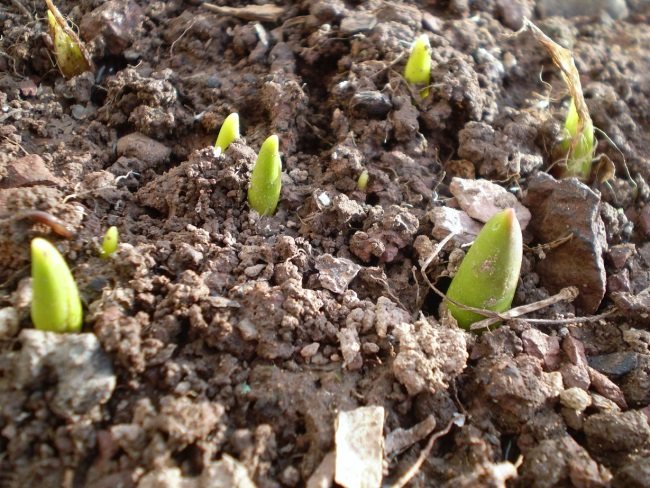

Hyacinths in spring
As soon as the first sprouts of hyacinths appeared, nitrogen feed for hyacinths (for example, 20-30 grams of ammonium nitrate per "square" of a flower garden). When the buds appear on the hyacinth, potassium and phosphorus (ammonium nitrate, superphosphate, potassium chloride - respectively, 20, 40 and 30 g per "square" of the garden) are added to the nitrogen fertilization. Hyacinth responds well to feeding with organic fertilizers - herbal infusions, bird droppings.
Hyacinth starts growing in the spring - leaves and inflorescences appear. The bulb "gives up" all the nutrients accumulated in the storing scales. Over time, these fleshy scales die off and become opaque - dry. The quality of the storage scales is very important for the hyacinth bulb, and it directly depends on the composition of the soil and feeding.
Hyacinth blooms from the end of April, but most varieties in May. The variety of color palette of hyacinths is amazing: white and cream, lilac and purple, blue and blue, crimson and pink. And what a delicate aroma the hyacinths exude!
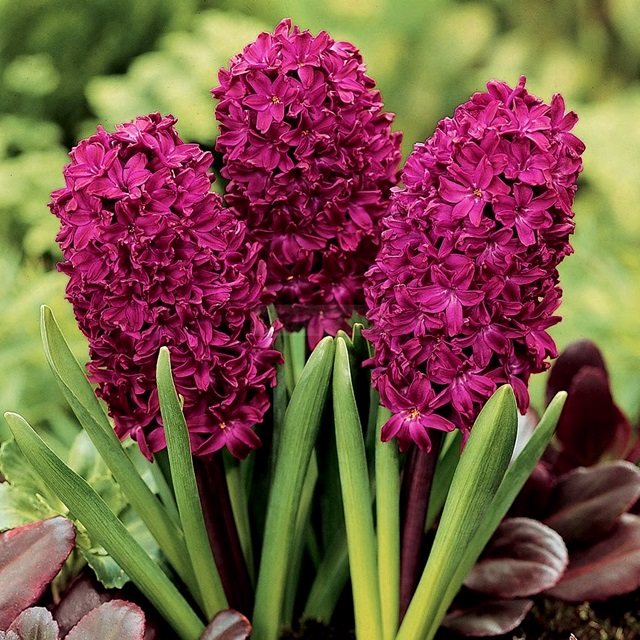

Hyacinth care after flowering
What to do after the hyacinth has faded? First of all, remove the peduncle and feed the plant, relying on phosphorus-potassium fertilizers (for example, superphosphate and potassium chloride - 40 grams per "square" of the flower garden). But you can not remove the leaves, as well as dig up the bulb immediately after flowering. Right now, the bulb accumulates nutrients from the ground to form a flower bud for the next year, and the leaves help it in this.
When the hyacinth leaves turn yellow and begin to dry out (usually in the second half of June or early July), it's time to dig up the hyacinth bulbs. Someone immediately cuts off the leaves and dries; some gardeners recommend to "dry up" the leaves along with the bulb in order to squeeze all the juices out of them in favor of the latter.For several days (5-7) the bulbs are dried at a temperature of about 20 degrees and with good ventilation, excess scales are removed, and large children are separated. If the children are very tiny, they can be left with their mother, carefully planted in the fall with the whole family, and separated the next summer.
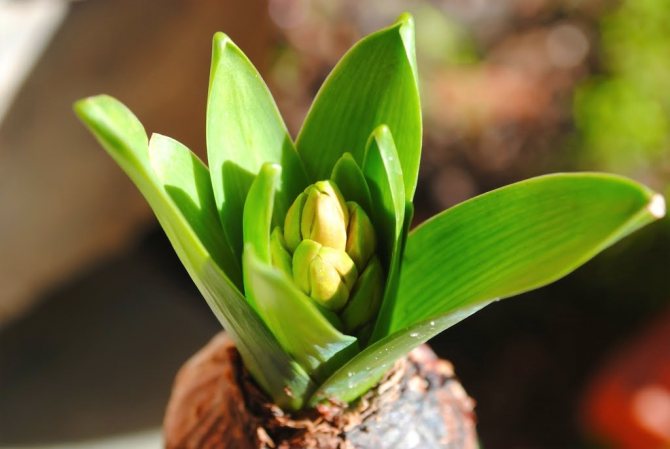

What happens if you don't dig up hyacinths in the summer? Firstly, this is guaranteed to weaken the plant - the bulb will not have time to rest. Secondly, the "schedule" of the hyacinth, already with difficulty in our climatic conditions, will go wrong. It often happens that such hyacinths bloom again at the end of summer, but ugly: a dense small inflorescence on a short stem. And next year such a hyacinth is unlikely to bloom: the flower bud has already been "spent", and there will not be enough time to form a new one.
When to dig up the plants?
In order for the hyacinth bulbs to remain healthy by spring and sprout next year, they must be removed from the ground in a timely manner for the winter. Digging up too early will prevent the bulb from filling up with nutrients from the soil. You should also not delay with this process.
Since hyacinth is an early flower, you can dig up the bulbs in mid-June. But again, it is not worth focusing only on the timing. There are other signs that the time has come to retrieve the plant.
Dig up the hyacinth after the inflorescences have faded and the upper third of the foliage has turned yellow. It is undesirable to wait until the bush is completely dry. Digging can cause the stem to break and make the bulb harder to reach. Also, if the husk is badly cracked, then at the time of digging the children may accidentally come off and remain in the soil.

